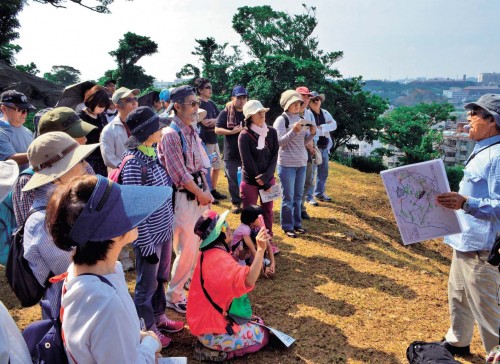“Peace Walk” tour around Battle of Okinawa sites in Urasoe, Naha

"Defense line," where the imperial Japanese army and the U.S. military waged a fierce battle. Standing on a hill beside Urasoe Castle Ruin, participants of the tour on April 26 traced how the Japanese Imperial Army had retreated.
April 27, 2015 Ryukyu Shimpo
A “Peace Walk” retracing some of the sites of the Battle of Okinawa was held on April 26. Sixty-three people viewed sites from Urasoe Castle Ruins to Shuri in Naha. Takamatsu Gushiken, the president of Gamafuya, a volunteer group dedicated to the recovery of human remains from the Battle of Okinawa, and 85-year-old war survivor Saneyoshi Furugen delivered speeches. At the age of 15, Furugen was conscripted into the Japanese Army’s Blood and Iron Student Corps.
Standing on the hill where Urasoe Castle Ruins are situated, those taking part in the tour looked down on an urban area. In Naha, they traced where a Japanese Imperial Army unit, which had initially gained ground below Shurijo castle, retreated.
Gushiken explained about a tomb damaged by a U.S. military shell in the Maeda district of Urasoe, which is currently being redeveloped. He said, “The law says that you have to carry out a cultural assets survey when even a bowl is unearthed. However, the Japanese government does nothing when human remains are unearthed.” Gushiken went on to say, “The government is at the very least responsible for returning the remains of those found to the family members.”
Standing in front of an underground trench at the Japanese 32nd Army’s headquarters close to Ryutan, Furugen talked about his war experiences. He said that he could not forget his classmates and seniors who were shot to death while screaming for their mothers. Furugen claimed, “Relying on military force, the Imperial Japanese Government turned Okinawa into hell. We should never have another war. That’s the best lesson from the battle of Okinawa.”
Twenty-four-year-old Kyoto resident Miho Fujii, who took part in the event, said, “I was able to know how fierce the battle was by taking the time to listen to the talks. When the local citizens fled to the southern area of the island, the imperial army decided to retreat in the same direction. That story made me realize how the imperial Japanese government sacrificed Okinawa.”
(English translation by T&CT)
Previous Article:Abe and Obama reaffirm they will go ahead with the Henoko relocation
Next Article:70 years after US occupation: Ceremony on Ie Island rejects war
[Similar Articles]
- DNA analysis identifies human remains in the Battle of Okinawa
- 10 sets of human remains unearthed in Japanese Army fortified shelter in Urasoe
- Three remains from the Battle of Okinawa found in Nishihara
- One of the largest wartime shelters discovered in northern Okinawa found in Motobu
- Some of Okinawan seen as spies in the Japanese Imperial Army documents during the Battle of Okinawa


 Webcam(Kokusai Street)
Webcam(Kokusai Street)


